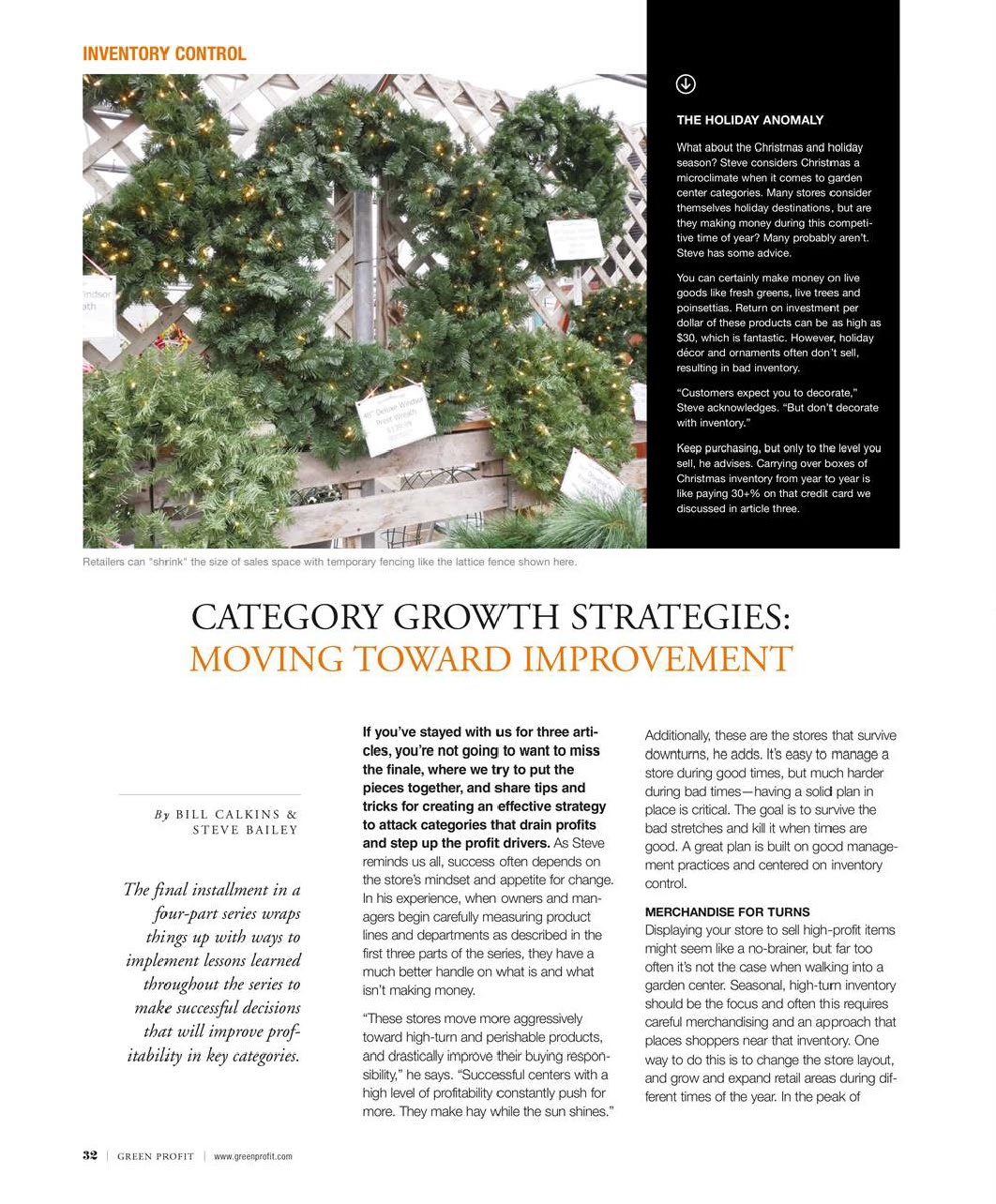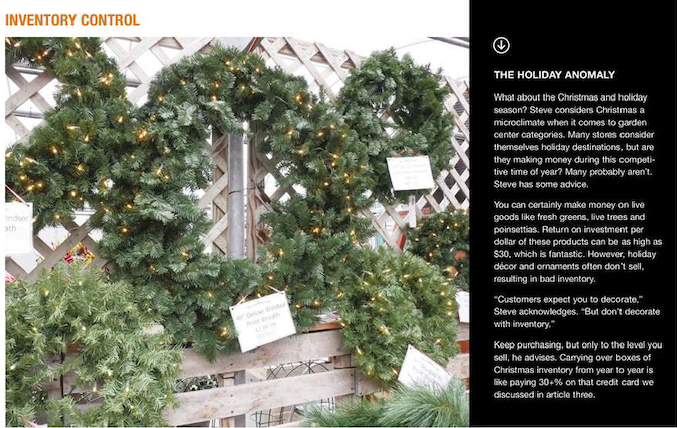Category Growth Strategies: Moving Toward Improvement-Part 4
Category Growth Strategies: Moving Toward Improvement
By Steve Bailey and Bill Calkins
The following is the Part 4 of the series... Category Growth Strategies: Moving Toward Improvement. This was originally published in the June edition of greenPROFIT magazine and can be seen HERE. If you missed the Part 1, you can see it HERE, Part 2 - HERE, or Part 3 - HERE.
Earlier this year, Ball Publishing's Bill Calkins approached Steve Bailey about co-writing a series of articles that could lead garden centers through the basics of analyzing category performance and some of the measurements developed for The Garden Center Group Clients through the Annual P&L Study. The result is a series of four articles published in Ball's GreenPROFIT magazine in this spring.
If you have been active in The Group at least a few years you have already been introduced to the details in this series but it is always great to have notes and a refresher article to recap what you are already working on here in The Group.
You may also download a PDF of this article HERE.
A special THANK YOU to both Steve Bailey and Bill Calkins for their efforts in developing this series and of course every one of the centers who have been a active part of The Garden Center Group since 2004 who have helped develop The Group's benchmarking programs!
The final installment in a four-part series wraps things up with ways to implement lessons learned throughout the series to make successful decisions that will improve profitability in key categories.
If you’ve stayed with us for three articles, you’re not going to want to miss the finale, where we try to put the pieces together, and share tips and tricks for creating an effective strategy to attack categories that drain profits and step up the profit drivers. As Steve reminds us all, success often depends on the store’s mindset and appetite for change. In his experience, when owners and managers begin carefully measuring product lines and departments as described in the first three parts of the series, they have a much better handle on what is and what isn’t making money.
“These stores move more aggressively toward high-turn and perishable products, and drastically improve their buying responsibility,” he says. “Successful centers with a high level of profitability constantly push for more. They make hay while the sun shines.”
Additionally, these are the stores that survive downturns, he adds. It’s easy to manage a store during good times, but much harder during bad times—having a solid plan in place is critical. The goal is to survive the bad stretches and kill it when times are good. A great plan is built on good management practices and centered on inventory control.
MERCHANDISE FOR TURNS
Displaying your store to sell high-profit items might seem like a no-brainer, but far too often it’s not the case when walking into a garden center. Seasonal, high-turn inventory should be the focus and often this requires careful merchandising and an approach that places shoppers near that inventory. One way to do this is to change the store layout, and grow and expand retail areas during different times of the year. In the peak of spring, most stores are packed to the gills with profitable live goods. Those are the good times. But what the store looks like before and after spring goes a long way to generating sales and profits.
One of the tricks Steve shares with the centers he consults with is to flex store spaces throughout the year to maximize sales. Cutting the field of vision for shoppers positions them near products and focuses their attention on the products you want them to buy during that season.
“The best method I’ve found for ‘shrinking’ a greenhouse is using moveable panels,” he says. “Use them to close off parts of the space and move them back and forth as product comes in and then sells.”
Putting panels on casters allows for easy movement and often just reducing the distance shoppers have to travel through the store leads to increased purchases. If you follow the buying advice in article three, you’ll more quickly sell through inventory before terms or dating end and then you can buy again.
Creating barriers to shrink space works well in outdoor spaces, too, according to Steve. “Try mounting fence panels on pallets,” he suggests. “Then you can use a forklift to move them in and out as product sells.”
This tactic is all about customer perception and when you have the ability to shrink a 2-acre garden center to half that size when product levels are low, your store will always look full.
But remember, when it comes to displaying product, don’t think you can put lipstick on a pig. A good buying plan and knowledge of what your shoppers want always trumps your artistic ability to showcase items.
“Bad displays of good products always outsell good displays of bad product,” Steve reminds. “Don’t spend time dressing up bad product. Just get rid of it.”
WHEN TO FOLD ’EM
No one wants to throw in the towel on a product line they’ve bought and paid for, but sometimes putting items on sale is just good business. Steve recommends managers walk the floors every week and look over the inventory, keeping mind the buying principles outlined throughout the series. When looking over the inventory, remember when you bought it and when you have to pay for it.
“When you get an invoice in, make a copy and put a date on it—when the merchandise should be sold,” he says. “Then stack the invoices on your desk (or file digitally) by week.”
Two weeks before it needs to be cleared out, consider putting it on sale. The best time to sell sale items is in peak season, when foot traffic is high, so don’t wait until slow times of the year to move product at a discount, he adds.
A final word on discounts and sales from Steve is that category-wide blowouts do nothing. “This tactic only moves your very best product, at a discount,” he says.
Think about it: If your customers see the entire pottery department on sale, they’ll no doubt cherry pick the best items and put them on the cart. You’ll still be left with the undesirables.
WHAT’S TRENDING?
Not a specific category, but product lines requiring foresight and planning, trends are something that can give your profitability a boost or really sting you.
“Trends are great,” Steve says. “They put you on the cutting edge and bring shoppers in.”
Where he sees retailers get into trouble is most often on the last buy. Measuring trend categories and products comes down to understanding GMROII, he explains. (As a reminder, we explained GMROII in the first part of this series, back in Green Profit’s March issue. It’s gross margin return on inventory investment: a 12-month measurement and inventory evaluation ratio analyzing your ability to turn inventory into cash.)
From Steve’s experience, most trends last a maximum of three years. Some are even quicker, while others remain. “The goal is to get in on the upside, before trends become commodities,” he says. “Maximize sales in year two and begin getting out in year three.” Keep a close eye on dropping revenues and dropping margin dollars, he warns. “With trends, it tends to be both at the same time.”
A couple trendy product lines Steve doesn’t recommend to garden centers are clothing and pet supplies. Of course, there are examples of stores who have succeeded in these categories, but they tend to already be in the game before these items became trendy and have excellent buyers who understand how these products work. Stores with strong pet departments usually have been selling pet for a long time, with established customer bases. They didn’t start carrying pet supplies when the online sales boom was in high gear.
WHEN CATEGORIES DECLINE
“Buying is a combination of art and science,” Steve says. “It’s a mix of intuition and numbers.” And the good buyers can balance both, he explains. They understand the constraint of a budget and use it to guide decision making.
Spotting category declines and reacting appropriately takes some experience, but there are warning signs to watch for, including slower turns and lower GMROII.
“Margin dollars and inventory turns are the indicators,” Steve says. “When they start dropping, it’s an early sign of a crash.” This is what good planning seeks to avoid.
IN CONCLUSION
Through this series, you’ve learned that there are proven ways to buy in all categories. We talked a lot about the benefits of a good mix of perishable and non-perishable lines, and that’s a big part of the profit puzzle.
“The focus for any garden center should be on perishable items—annuals, perennials, shrubs and trees,” Steve suggests. “Your non-perishables should complement, but never outweigh, live goods.”
When stores shift focus from perishables to non-perishables, margin dollars will drop, he says. When this happens, chances are you won’t meet fixed expenses and overhead or cash flow demands.
Now is the time to get even smarter about business and there are many tools available to assist in this effort. If you need a place to start and you’ve enjoyed this article series, consider giving Steve a call or reaching out to The Garden Center Group. Contact info can be found at the end of this article.
Steve says many garden center owners don’t fully understand a balance sheet and how to use it to maximize profitability.
“They put in a lot of sweat equity, but it doesn’t equate to wealth,” he says. “Your sweat equity should result in monetary equity at the end of the year.”
Remember, profit builds wealth and the path to profit requires a plan. We hope this series of articles has driven home the need for a roadmap in every store category, as well as some guidance as to what metrics will deliver the data you need. Take all of this information, gather your team and begin mapping out your plan of attack moving forward.
You can do it!
Did you miss Parts 1, 2 and 3? Go to the beginning of the series HERE.

